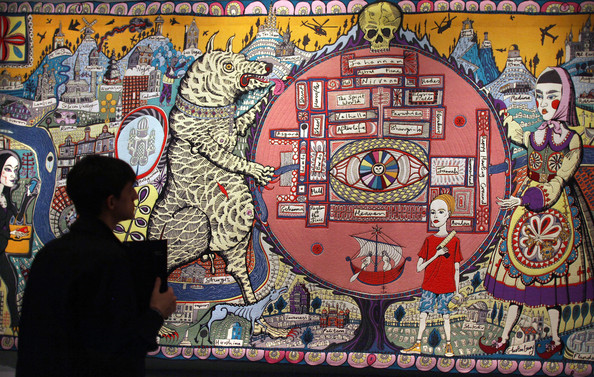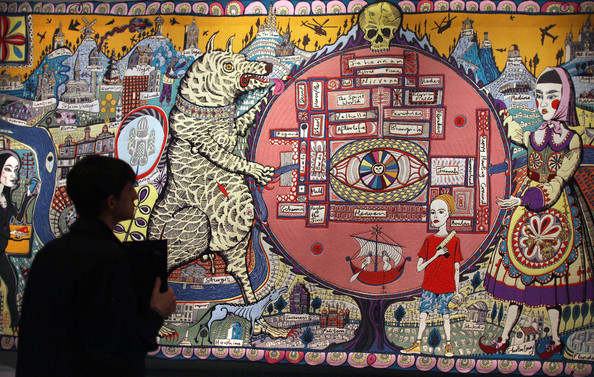
Who would have thought that the British Museum could be accused of ‘selling out’ to the masses? Since October, the much loved institution has attracted a great surge of newcomers through its doors, and Grayson Perry is the cross-dressing potter responsible.
But what has motivated people to make the visit? Is it simply Perry’s newfound celebrity status? Indeed, the question is being raised, tongue firmly in cheek, through the first artwork featured, a pot called You Are Here. Depictions of you, the public, and your defensive responses to the exhibition are imagined on the pot’s surface. Maybe you were enticed by the ‘buzz on Twitter’, or, like the scribbled image of a sceptic, you needed your ‘negative prejudices’ about the artist and his work confirmed. Perhaps, like a baffled onlooker, you simply ‘wandered in.’ Admittedly, I could relate to more than one of these suggestions.
Over the past tow and a half years, the Turner Prize-winning artist has curated the British Museum’s current exhibition, a labour of love that juxtaposes 30 of his own works with some 170 pieces carefully selected from the museum’s vast collection. The Tomb of the Unknown Craftsman brings together innumerable cultures spanning thousands of years, and combines a wealth of visual intrigue as a sort of voyage through Perry’s personal obsessions. There is everything from invaluable ornaments to cheap and banal keepsakes, each organised thematically under such titles as ‘shrines’ and ‘sexuality.’ Across the threshold to the show stands an enormous fluorescent pink custom-built motorbike that must be seen to be believed. Whatever you may think of the artist, his ambitions are pretty impressive.
The exhibition reminds me that whilst Perry creates art unselfconsciously, he also maintains a keen self-awareness of his role as an artist, a potter, a craftsman, and a creative mind. The exhibition’s brilliant title is a poignant comment on the age of the ‘celebrity artist’, and also a reminder that Perry is as good with words as he is with images. Here, where ancient crafts are aligned with modern art, the objects come first and creators retain their anonymity. The ‘pilgrimage’ made by the spectator to the gallery, an idea that fascinates Perry, is an homage to the things themselves, and to the notion of craftsmanship.
The show’s concept may seem difficult to digest, given that Perry has jumbled up such historicially valuable and priceless items with his own, newer creations, to which his personality is necessarily inextricably linked. His 50-year old teddy-bear deity, Alan Measles, also plays a large part. More questions arise: ‘Do not look too hard for meaning here’, reads the first line of the artist’s statement, and yet most of the objects on display are captioned with a piece of Perry philosophy. For some, the fact that these artifacts have been re-located into this so-called ‘fantasy world’ is somewhat maddening.
That this exhibition could be thought of as being in any way ill-matched is, for me, a rather short-sighted response to such an unusual and multi-layered project. With Grayson Perry being one of this country’s most articulate artists, the philosophy underpinning the show certainly seems acceptable to me. Regardless of his eccentricities, Perry always gets straight to the point, which is perhaps unusual for a contemporary artist – but what a relief it is.
‘I am not a historian, I am an artist’, explains Perry, summing up in a sentence what has caused all the fuss, for conventionally these are objects you would expect to see and appreciate within some sort of historical context. As we well know, artifacts are often viewed in a certain way; helpfully arranged and stamped with an objective, official narrative. And just as often, you are inclined to read the caption provided before even attempting to form a response of your own.
The result, I believe, leads viewers towards a lack of instinctive visual engagement. Yet Perry undermines this impulse by juxtaposing seemingly incongruous items, and allowing for links to be forged between ancient and modern ideas, values and aesthetic qualities. Placing a ‘Hello Kitty’ hand-towel amongst objects such as an Egyptian soul house or a Buddhist votive offering is far more than a merely provocative gesture; it forces the viewer to consider the objects, at least initially, on sheer aesthetic alone. It also impels you to look twice. Several things I initially presumed to be ancient, actually harked back to no earlier than the 1990s. Like the role-play in a guessing game, viewers find themselves deciding the ‘worth’ of the objects on an individual level, as well as questioning the notion of ‘worth’ itself. Let loose amongst the millions of artifacts the museum holds, which would you choose to display and for what reason?
There is a huge amount of affection and humour that has been put into the parodying of other work with his own, as well as an instinctive understanding for materials. It seems clear that beyond anything you may read about Perry, and perhaps more tellingly, he is someone completely obsessed with imagery and the simple act of looking. I like him for this, and I also like him for his honesty, and for his utter lack of pretentiousness. Yes, it might be bonkers, but it certainly strikes a genuine note, and this is what people respond to. The Tomb of the Unknown Craftsman brings static, unfamiliar pieces of history to life through one person’s very particular vision. It is compact – somehow smaller than I had imagined from all the media hype – but hardly short of visual intrigue.



Leave a Reply